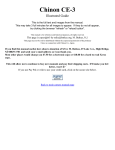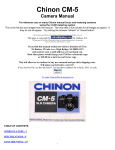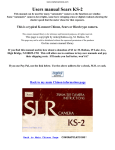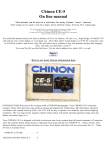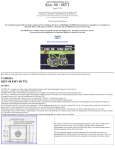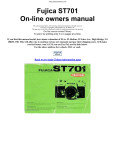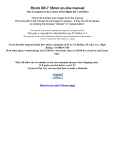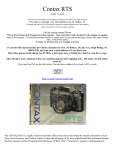Download CHINON ZOOM LENS Specifications
Transcript
www.orphancameras.com Chinon CG-5 On-line users manual This camera manual library is for reference and historical purposes, all rights reserved. This page is copyright© by [email protected], M. Butkus, NJ. This page may not be sold or distributed without the expressed permission of the producer I have no connection with Chinon Co., Japan On-line camera manual library Back to main on-line manual page If you find this manual useful, how about a donation of $3 to: M. Butkus, 29 Lake Ave., High Bridge, NJ 08829-17010 This will allow me to continue to buy new manuals and pay their shipping costs. It'll make you feel better, won't it? If you use Pay Pal, use the link below. Use the above address for a check, M.O. or cash. www.orphancameras.com Back to main page on-line manual page NOMENCLATURE ......................................... 4 SPECIFICATIONS FOR CG-5 ....................... 6 LENS MOUNTING ...................................... 14 BATTERY INSTALLATION ..... ................... 16 BATTERY TESTING ................................. ....20 FILM LOADING ........................................... 22 FRAME COUNTER ..................................... 26 FILM ADVANCEMENT ............................... 28 ASA SETTING ............................................. 28 www.orphancameras.com FOCUSING ................................................. 30 AUTO FOCUSING ...................................... 34 AUTOMATIC EXPOSURE .......................... 36 F STOP SELECTION .................................... 40 SHUTTER RELEASE AND RELEASE LOCK 42 UNLOADING EXPOSED FILM .................... 44 DEPTH OF FIELD .......................................... 46 USING A TRIPOD ...................................... . 48 SELF TIMER ................................................... 50 MANUAL EXPOSURE .................................. 52 MULTIPLE EXPOSURE ................................ 56 EXPOSURE MEMORY ................................. 58 EXPOSURE COMPENSATION ................... 62 THE FLASH SYSTEM ................................... 64 CHINON POWER WINDER (PW-535) ........ 68 www.orphancameras.com AUTO FOCUS 50MM MC F/1.7 LENS ........ 70 AUTO FOCUS 35-70MM F/3.3 - 4.5 ZOOM LENS ...................................................71 INFO BACK IMPRINTING UNIT ............. 72 INFO BACK-2 DIGITAL DATA-IMPRINTING UNIT ............. 72 AUTO DATE QUARTZ DIGITAL DATA-IMPRINTING UNIT .................... 73 INFRARED PHOTOGRAPHY ...................... 74 SHOULDER STRAP INSTRUCTIONS ......... 76 OPTIONAL ACCESSORIES ................... 78 CARE OF THE CAMERA 1. Shutter speed dial 2. Film advance lever 3. Shutter release button 4. Frame counter window 5. Multiple exposure lever 6. Shoulder strap eyelet 7. AF electronic contacts 8. Depth of field lever www.4.butkus.org 9. Self-timer dial with LED 10. Lens lock release lever 11. Body grip setting holes www.orphancameras.com 12. Accessory shoe (Hot shoe) 13. Film rewind knob and back opening knob 14. Film speed dial (ASA/ISO) Exposure compensation dial 15. Aperture ring 16. Depth of field scale 17. X sync socket www.orphancameras.com 18. Focusing ring 19. Exposure memory button 20. Viewfinder eyepiece 21. Metal focal plane shutter 22. Film chamber 23. Film rail www.orphancameras.com 24. Film guide rail 25. Power winder electronic contacts 26. Battery chamber her cover 27. Tripod socket 28. Sprocket teeth 29. Take-up spool 30. Camera back 31. Film pressure plate 32. Power winder coupler 33. Auto Date electronic contacts 34. Rewind button INTRODUCTION Welcome to the exciting world of CHINON photography. Your CHINON CG-5 electronic compact 35mm SLR represents state -of-the-art design and engineering. Employing a full information electronic viewfinder with variable intensity LED's, the CG-5 will be easy to operate even under the most adverse lighting conditions. The two stage electro magnetic shutter release button will permit metering operation (stage one) and shutter activation (stage two). Your CHINON CG-5 is designed with built-in electronic auto focus contacts that will permit automatic AF operation when the camera's shutter release button Is depressed when used with the new CHINON 35 - 70mm AF lens. This advanced feature ensures accurate focusing every time, since shutter activation will not occur unless the 35 - 70mm AF lens is in proper focus. (Mike: and if you can't get a focus, it won't fire. Just like the CP9-AF model) SPECIFICATIONS FOR CG-5 Type: 35 mm automatic SLR (Single Lens Reflex) compact camera with aperture priority exposure system (AE). www.orphancameras.com Picture Format: 24 x 36 mm Film Loading: Easy film loading by multi -slot take up spool. Lens Mount: CHINON Bayonet Mount Standard Lenses: CHINON 50 mm F/1.4,50 mm F/1.7',45 mm F/2.8,50 mm F/1.7 AF (All stop down to F/22),50 mm F/1.9 Mirror: Large quick return, shockless system Shutter: Seiko MFC electromagnetic metal focal plane shutter with downward vertical path; stepless speeds from 1 to 1/1000 sec. on automatic; 13 speeds from 4 to 1/1000 sec. on manual, "B". Both automatic and manual speeds electronically controlled. Shutter Release: Two stage electromagnetic type with safety lock and provision for cable release. Viewfinder: Fixed eye-level pentaprism, central split image with microprism collar and ground glass, 15 LED's indicate shutter speed, AF operation Flash sync, over/under exposure and low light condition in 2 different colors. Over/under exposure red LED will glow when exposure is 1 EV higher or lower. Viewfinder Magnification: 0.87 x with 50 mm lens set at infinity. Viewfinder Visibility: 92%. Depth of Field Preview: By depressing depth of field lever. Exposure Meter: TTL, Center weighted full aperture system employing two silicon blue photo cells located on each side of viewfinder. Exposure Preview: By depressing shutter release half way metering system is activated. Manual Exposure System: Complete manual override capability, match LED system. Memory Lock: Built-in exposure memory lock system. Exposure Compensation: Built-in + 1 EV in one third stop increments. Exposure Range: EV-1 (F/1.4@ 4 sec.) to EV +19 (F/22@ 1/1000) ASA 100 50 mm F/1.4 lens. www.orphancameras.com ASA/ISO Range: 25-3200 (DIN 15-36) with safety lock. Film Advance: Single stroke in an arc of 130° with 25° stand off, motorized film advance with CHINON POWER WINDER (PW-535). Multiple Exposure: Built-in switch which disengages film advance and frame counter. Automatically resets to normal position after each film advancement. UNLIMITED. Film Counter: Automatically indicates number of exposures and resets to "S" when camera back is opened. Does not advance during multiple exposure. Self-Timer: Electronically controlled at 10 seconds with flashing red LED indicator together with a piezo ceramic buzzer (audible signal). Two seconds before exposure flashing frequency of red LED increases. Self-timer can be canceled even after system has been activated. Film Rewind: By depressing the rewind button and cranking the rewind lever. Rewind button automatically resets when the film advance lever is turned. Accessory Shoe: Hot shoe type with X sync. and contact for CHINON dedicated flash. Synchronization: "X" strobe sync. at 1/90 sec. Flash System: CHINON dedicated flash or most convention flashes. Special Contacts for CHINON AF lens: Built-in with AF indicator in viewfinder (green LED). The shutter is not activated unless the lens is set to the correct focusing distance. (Mike: these lenses are almost impossible to find but will work correctly with this model) Special Contacts for CHINON Auto Date: Built-in Power Source: Two 1.5V Alkaline batteries (SL44, A76) or silver oxide batteries (G-13, LR44, MS76). 4www.butkus.org Battery Test: Built-in with LED indicator. www.4.butkus.org Body Finish: Black. Accessories: CHINON Power Winders (PW-535 & PW-545), dedicated flashes, Info Back-2 data imprinting unit, Auto Date Quartz digital data imprinting unit, Super multi-coated lenses, Autofocus lenses, Deluxe carrying cases and many more. Body Dimensions: 135.5 x 88 x 50.5 mm 5.33(W) x 3.46(H) x 1.99(D)". www.orphancameras.com Body Weight: 455 grams LENS MOUNTING Your CHINON CG-5 is equipped with a CHINON bayonet mount which accepts all interchangeable lenses with the bayonet mount. To attach the lens, match the red dot on the camera body with the red dot on the lens (Fig. 1). Then insert the lens into the camera body and turn it clockwise until the lens locks with a click. To remove the lens from the camera body, depress and hold the lens lock release lever on the camera body, turn the lens counterclockwise as far as it will go, and lift it up from the body (Fig. 2). BATTERY INSTALLATION Using a coin, unlock the battery chamber cover by turning it counterclockwise. Place two 1 .5V Alkaline batteries (SR-44, A-76) or equivalent (G-13, LR-44, MS-76) in the battery chamber with the negative (-) side facing downwards (Fig. 3). Carefully insert the batteries into the camera body. Replace and tighten the cover securely by turning it clockwise (Fig 4). NOTE: Clean the batteries with a dry cloth or paper before inserting and thereafter at regular intervals. Make sure that the batteries are inserted correctly, i.e., check polarity. The shutter will operate only when batteries are correctly installed and not exhausted. www.orphancameras.com Body Grip (Spare battery storage compartment) You can attach an optional (standard in U.S.) body grip to your CG-5 camera (Fig. 5). To do so, attach the body grip to corresponding body grip setting holes on the camera and tighten the screw on the bottom of the body grip by turning it clockwise. The body grip has a convenient battery storage compartment in which you may store one set (2 pcs.) of spare batteries. To remove the batteries from the compartment, pull on the battery holding lever (Fig. 6). BATTERY TESTING Set the shutter speed dial to any shutter speed setting (except "B" and "OFF" position) (Fig. 7), and while looking at the shutter speed indicator scale in the viewfinder, slightly depress the shutter release button. If the batteries are in good condition (battery potential is high enough) at least one of LED indicators (except the top two LED's) will light up. (Fig. 8) if a LED fails to illuminate, the batteries are too weak and need to be replaced, they are incorrectly inserted, or the shutter speed dial is set in "OFF" or "B". www.orphancameras.com FILM LOADING Pull out the film rewind knob until the camera back pops open (Fig. 9). Then drop a film cartridge into the film chamber with its protruding end facing the bottom of the camera (Fig. 10). Push in the film rewind knob and slightly turn the knob in either direction until it catches the film cartridge spool. Insert the trimmed end of the film into a slot of the multi-slotted take-up spool. Turn the shutter speed selector to any setting except "AUTO" or "OFF" and advance www.orphancameras.com the film while holding the film lightly down on to the transport sprockets. Release the shutter if necessary and advance the film until the sprockets engage with the upper and lower perforations of the film (Fig. 11). Then close the camera back firmly until it locks with a click. Now turn the film rewind knob gently until all the slack is taken up and the rewind knob stops. Do not force or further rewind the film (Fig. 12). www.4.butkus.org Advance the film and release the shutter three times (Fig. 13). The rewind knob should rotate counterclockwise as the film is advanced and the "1 " marking should appear in the frame counter window (Fig. 14). Turn the shutter speed dial to the "AUTO" position (Fig. 15). A convenient memo holder is provided on the back of your camera. Whenever you load new film, just cut off the top of the film box and put it in the memo holder as a reminder (Fig. 16). www.orphancameras.com FRAME COUNTER You CHINON CG5 equipped with a frame counter which displays the number of exposures made and resets automatically upon opening the camera back. At the very beginning the counter shows "S" indicating the start of the picture taking process. When a film is loaded according to the procedure previously described, the counter displays "1 " indicating that the camera is ready for the first exposure. Every time the film advance lever is turned the counter will proceed one stop forward. The numbers 24 and 36 are colored in orange to warn the end of commonly available films (Fig. 17). www.orphancameras.com FILM ADVANCEMENT When the film end is reached the film advance lever may stop before the lever is fully turned. Do not force the lever. Stop winding at once and rewind the film. Refer to "UNLOADING EXPOSED FILM." ASA SETTING The film speed dial located on top of the camera is coupled directly to the internal exposure control circuitry and the correct exposure factor for the film is automatically set by aligning the ASA number of the film you are using with the index mark on the camera body (Fig. 18). The ASA number of the film is printed on the film box or in the instruction sheet packed with the film. Pull out the film speed dial and turn the dial to align the appropriate ASA number with the green index mark. Be sure to check the ASA number whenever you put new film into the camera. www.orphancameras.com FOCUSING At the center of the viewfinder is the split image with microprism collar which is then surrounded by ground glass. When the camera is in focus, the image on these focusing aids becomes sharpest. While observing the subject through the viewfinder, turn the lens focus ring until the upper and lower split images match up to form a uniform image (Fig. 19). This split image focusing is particularly helpful when the subject is dominated by vertical lines. The microprism is also very helpful. When it is out of focus, the image on the microprism will be composed of a collection of asterisks (Fig. 20). These sparkling asterisks will disappear when the focus is properly set. You can double check the focus setting by the image on the ground glass. www.4.butkus.org www.orphancameras.com You can also focus indirectly. Actually measure or estimate the distance to the subject and set the lens focus ring to the appropriate setting (Fig. 21). www.orphancameras.com AUTO FOCUSING Your CHINON CG-5 has built-in AF electronic contacts which activate CHINON 35 - 70mm Auto Focus Lens by depressing the shutter release button of the camera or the Auto Focus Button on the auto focus lens unit. To activate the AF system, operate the film advance lever, look through the viewfinder, center the subject by utilizing the split image with microprism collar in the viewfinder, then depressing the shutter release button halfway. The focusing ring will automatically rotate until the subject is in focus (Fig. 22). You may also focus by depressing the auto focus button on the auto focus lens unit. When the camera is in focus, the green AF LED in the viewfinder will glow (Fig. 23) and the shutter can be released. www.orphancameras.com AUTOMATIC EXPOSURE Your CHINON CG-5 features TTL, center weighted full aperture light measuring automatic exposure control. As long as the shutter speed dial is set in "AUTO" you don't have to worry about the exposure factor (Fig. 24). The sensitive and accurate internal circuitry will compute the correct exposure for the photographic condition and control the shutter speeds stepless from a 1 sec. time exposure to a fast 1/1000 sec. When the shutter release button is depressed halfway, the exposure control circuit is energized and will be in the monitoring stage (Fig. 25). www.orphancameras.com You can see the computerized shutter speed displayed in the viewfinder by red and green LED's (Fig. 26). If the lens F stop or the aperture size is too large for the lighting condition, the red over exposure indicator (third from the top of the scale) will glow (Fig. 27). when this happens, stop down the lens diaphragm by turning the lens F stop ring or use a film with a lower ASA number. www.orphancameras.com Another alternative is to use an ND (neutral density) filter in front of the lens. They are available as accessories from your local dealer. If the displayed speed is 1/30 or slower ( Red LED's), use of a tripod is recommended, or you can increase the shutter speed by opening the lens diaphragm. Use of a flash unit is also suggested (refer to "CHINON Dedicated Flash System"). If the computed shutter speed is even longer then 1 sec. (semi darkness condition), the under exposure indicator (Red LED) at the bottom of the scale will light up when the available light is less than 1 EV (Fig. 28). www.orphancameras.com F STOP SELECTION The following may be used as a guide to determine the lens F stop when you are using the camera in the automatic mode. www.4.butkus.org Sunny day outside . F/8 - F/ 11 Cloudy day outside . F/4 - F/ 5.6 Inside (without flash . F/1.4 - F/2.8 SHUTTER RELEASE AND RELEASE LOCK Your CHINON CG-5 features a two stage electromagnetic shutter release with safety lock. When the shutter release button is depressed half way, the electronic circuit starts functioning. When the button is fully depressed, it will trigger the shutter. Always hold the camera steady and gently depress the shutter release button to make an exposure. The position marked "OFF" on the shutter speed dial is the shutter release safety lock position. When this is aligned with the index mark, the batteries are disconnected from the circuit and exposure cannot be made (Fig. 29). This position is also used when the camera is not to be used for a long time. www.orphancameras.com UNLOADING EXPOSED FILM When the film in the camera is fully exposed, the film advance lever will stop. Do not attempt to force the lever any further, but rewind the film and replace with a new one. Push in the rewind lock release button at the bottom of the camera (Fig. 30). Unfold the rewind crank of the rewind knob (Fig. 31). Turn the rewind crank clockwise. You will feel friction as the film is rewound. Suddenly, when the film is rewound completely, the friction decreases and the rewind crank will turn with ease. Then pull out the rewind knob to open the camera back (Fig. 32). When the camera back is opened, the frame counter will automatically reset to "S". The rewind lock release button on the bottom of the camera will pop out upon the next advancement of the film advance lever. Your exposed film should be processed without delay. www.orphancameras.com DEPTH OF FIELD Depth of field designates the nearest and furthest limits of the area that will be sharp in the picture in front of and beyond the subject. Depth of field is controlled by the f/stop. The larger the lens opening (f/stop), the shallower is the depth of field. The smaller the lens opening, the greater the depth of field will become (Fig. 33 and 34). Visible Check in the Viewfinder www.orphancameras.com Set the lens at a selected lens opening on the f/stop ring. Depress the depth of field lever and observe the subject through the viewfinder. This will enable you to preview the area of sharpness in the picture before shooting. (Fig. 35) Depth of Field Scale: The depth of field scale indicates (after focusing) the approximate area that will be sharp in the picture. Locate on the depth of field scale the corresponding pair of f/stop figures. The distance between these two f/ stop figures on the focusing ring will be the area of sharpness in your picture (Fig. 36). NOTE: Do not depress the shutter release button while depressing the depth of field lever. www.orphancameras.com USING A TRIPOD The tripod socket at the base of the CHINON camera is designed to accept standard tripod threads having a depth no greater than 5.5 mm (0.22 inch). To prevent any possibility of damage to the camera's internal mechanism, DO NOT use tripods with longer mounting screws and always avoid over tightening. www.orphancameras.com SELF TIMER Your CHINON CG-5 is equipped with a electronic self timer with a red LED indicator together with a piezo ceramic buzzer (audible signal). The built-in self timer electronically delays the shutter release for 10 seconds. First select the desired delay by rotating the self timer dial (Fig. 37). The camera should be mounted on a firm support during self timer operation. Now to activate the system simply depress the shutter release button. You will notice the red self timer LED blinking with the piezo ceramic buzzer (audible signal) and two seconds before the shutter release the flashing frequency will increase giving you or your audience time to smile. The self timer may also be utilized for releasing the shutter at low shutter speeds when a cable release is not available. If you decided not to use the self timer or to change the delay time, you can cancel or rest the timer even after the function is indicated. Just return the dial to normal position for cancellation and reset the time again. NOTE: Change of delay time can only be made after cancellation. MANUAL EXPOSURE By moving the shutter speed dial Off the "AUTO" setting manual shutter speeds can be set. There are two methods of selecting the correct exposure. 1. Set the required shutter speed on the dial. While depressing the shutter release button until the meter activates, observe the flashing LED in the viewfinder. Rotate the lens aperture ring until the second LED aligns with the flashing shutter speed LED on the scale in the viewfinder (Fig. 38) . 2. Set the required aperture on the lens. Depress the shutter release button until the meter activates and observe which shutter speed is indicated in the viewfinder by an LED. You will also observe a flashing LED in the viewfinder. By adjusting the shutter speed until both LED's are coincident, correct exposure will result (Fig. 39). www.orphancameras.com Time Exposure (Night Photography) Set the shutter speed dial to the "B" position. The shutter mirror will reflex to the open (up) position while the shutter release button is depressed. Use of a cable release and a tripod is recommended for stability to prevent vibration during time exposures. (Fig. 40) www.orphancameras.com MULTIPLE EXPOSURE Another attractive feature of your CHINON CG-5 is the built-in unlimited multiple exposure provision. The multiple exposure lever is located in front of the film advance lever (Fig. 41). When you activate the film advance lever simply press and hold the multiple exposure lever to the left. This lever should be held throughout the film advancement. By doing so the film advance mechanism and the film counter will be disengaged. Only the shutter will be charged when the film advance lever is activated. Therefore, the film will not advance and you can make unlimited multiple exposures on any single frame. NOTE: You can make multiple exposures as many times as you wish. However, each time the multiple exposure lever must be held before and throughout the film advancement. www.orphancameras.com EXPOSURE MEMORY Under normal circumstances your CHINON CG-5 camera will produce perfectly exposed photographs, due to the integrated automatic exposure circuit. However, some lighting conditions might occur that could misguide the system, such as subjects with a very high contrast or strongly back-lit scenes. In such cases the exposure memory feature should be used. 1. Focus the Subject. Make sure that the shutter speed dial is set to the "AUTO" position. (Fig. 42). 2. Depress the shutter release button half way and measure the light on the main part of the subject you want to shoot excluding all unnecessary light from the side or background (Fig. 43). Then press the exposure memory button once which will instantly memorize the light value of the subject (Fig. 44). Once the button is depressed, there is no need to hold the exposure memory button further as long as the shutter release button is depressed halfway. 3. Compose the subject in the viewfinder as you desire (Fig. 45). Then press the shutter release button all the way to take the photograph. The shutter speed indicator (LED) in the viewfinder will glow signaling the "memorized" shutter speed once the exposure memory button is depressed. www.orphancameras.com EXPOSURE COMPENSATION Your CHINON CG-5 camera incorporates an exposure compensation dial which can be unitized for special purposes such as bracketing exposure, compensation for back-lit or spot lit situations. If you would prefer darker or brighter pictures than those obtained by the automatic exposure, this feature is very helpful. You can change the exposure factor up to one full stop either plus or minus in 1/3 EV increments. Pull out and turn the Film speed dial to the desired position (Fig. 46). NOTE: After exposures have been made, be sure to return the dial to the normal exposure position. www.orphancameras.com (1 ) -1 EV over (2) - 2/3 EV over (3) -1 /3 EV over (4) - Normal exposure (5) -1 /3 EV under (6) - 2/3 EV under (7) -1 EV under THE FLASH SYSTEM Specially designed and developed automatic flash units are available for your CHINON CG-5 as accessories. This highly advanced dedicated flash system permits carefree flash photography. You no longer have to alter the shutter speed dial from any position since the www.orphancameras.com flash is integrated electronically with the camera body. Set the f/stop indicated on the exposure calculator dial of your CHINON flash to the corresponding aperture ring on the lens. A few seconds after your CHINON flash is turned to ON position the flash ready-light will illuminate. CHINON CG-5 has a special viewfinder ready light system which is electronically coupled to the auto flash. When the flash has reached adequate power, the shutter speed is automatically set to the 1/90 sec. and the flash ready indicator (red LED) will glow signaling the camera flash are ready to operate (Fig. 47). After the picture has been taken and before the flash has recycled, the camera will automatically switch to the automatic or manual mode until the flash has once again recycled. In this case, your flash must be set to the "AUTO" position. Other electronic flash can be utilized with your CHINON CG-5 camera. However, if they do not incorporate a built-in hot shoe, a P.C. cord must be connected to the "X" synchronization terminal on your C G-5 for proper flash synchronization. Also the shutter speed dial must be set to 1/60 sec. flash synchronization position (Fig. 48 and 49). NOTE: When "FP" or "M" type flash bulbs are used, the shutter speed must be set to 1/15 sec. Use of a tripod for low shutter speed photography is always recommended. Always refer to the instructions enclosed with your electronic flash for additional operating instructions. www.orphancameras.com CHINON POWER WINDER (PW-535) Your CHINON CG-5 compact single lens reflex camera can also be used with the new CHINON Power Winder when motorized photography is desired. This sophisticated accessory enhances the versatility of your new camera and opens up new horizons for creative photography. The Power Winder, designed with latest electronic technology, employs a special computer "memory" chip which monitors key functions essential to motorized photography (Fig. 50). When using a CHINON Auto Focus lens with the Power Winder the shutter will not be released until the lens is in focus. You may utilize a specially designed remote control unit which permits full automatic remote control operation from 40M (132 ft.) away from the camera. (Fig. 51) NOTE: To attach a CHINON Power Winder to the camera body, the body aria has to be removed from the www.orphancameras.com AUTO FOCUS 50MM MC F/1.7 LENS Remarkable infrared auto focus lens automatically focuses the subject even in total darkness Stepless operation from 1 M (3 3 ft ) ~ Aperture range from f/1 7 - f/22 Audible signal beeps when subject is in focus, plus green LED in CG-5 viewfinder glows indicating proper focus AUTO FOCUS 35 70MM F'3.3 - 4 5 ZOOM LENS CHINON CG-5 and the AF lenses have special built-in auto focus contacts therein to make possible full auto focusing control by depressing the shutter release button halfway Operation same as 50mm AF lens Aperture range f/3.3- f/22 Lens construction: 7 elements in 7 groups Built-in power on/off switch When the subject is too close to be auto-focused (when the subject is less than 1 M is 3 ft )), a continuous audible signal will be emitted, signaling manual focusing is required INFO BACK IMPRINTING UNIT (DB-010) Accessory data back features electronic input of up to 30 characters (alpha or numeric) of information onto your negative or slide, via a compact 36 button digital control panel. Built-in memory feature will continuously imprint the same message or you can change the information as you like INFO BACK-2 DIGITAL DATA-IMPRINTING UNIT (DP-520) Deluxe accessory data back Same features as Info Back (DB-010) plus LCD readout via built-in monitor window AUTO DATE QUARTZ DIGITAL DATA IMPRINTING UNIT (AD-510) www.orphancameras.com Accessory data back featuring electronic imprint of year, month, day or hour, minute directly on your negative or slide Data automatically resets until year 2019. INFRA-RED PHOTOGRAPHY Your CHINON CG-5 camera will accept Infra-red film. To use Infra-red film an extra focusing adjustment must be made. After focusing note the figure that is adjacent to the red diamond on the distance scale (Fig. 52) then move that figure over to the infra-red mark engraved on the lens. This adjustment is only required for black and white infra-red film. When using color infra-red film, focus in the normal way. NOTE: Read the instructions packed with the infra-red film for further instructions. SHOULDER STRAP INSTRUCTIONS Place the end of the shoulder strap through the retaining ring connected to the camera body lug. Fold the shoulder strap over the retaining ring. Place the ends of the strap through the plastic retainer and strap buckle. Pull tight to secure. Follow the same procedure for the other side of the camera. To secure the camera case to the camera body, place the retaining strap behind and around the neck strap lug and then snap the retaining strap into place securely. OPTIONAL ACCESSORIES Standard Lenses 45 mm f/2 8 50mm f/1 9 50 mm f/1 7 multicoated www.orphancameras.com 50 mm f/1.7 AF 50 mm f/1 4 multicoated Wide-angle Lenses 28 mm f/2 8 multicoated 3 5 mm f/ 2 .8 multi coated Telephoto Lenses 135 mm f/2 8 multicoated 200 mm f/3 5 multicoated 300 mm f/5.6 multicoated 500 mm f/8 reflex type Zoom Lenses 35 - 70mm f/3.3 - 4 5 AF Zoom 28 - 50 mm f/3 5 - 4 5 multicoated 35 - 70 mm f/2 7 - 3 5 multicoated MACRO 35 -100mm f/3.5 - 43 multicoated 80 - 200 mm f/3.8 multicoated MACRO Accessories (CHINON Power Winder (PW-535 & PW-545) Info Back www.orphancameras.com Info Back-2 Auto Date CHINO Auto S 180 flash CHINON Auto S-240 flash CHINON Auto S-280 flash Synchro-eye for flash (Slave Unit) Wireless Remote Control set for power winder Deluxe Carrying Case Neck Strap Filter (Skylight, UV, Y2, ND4X, PL) Rubber Eyepiece Eyepiece Adapter ( - 3, + 1, + 3) Angle Finder 2 clips lens cap 1 5 V Alkaline Battery (3 pcs in on set) Rubber Lens hood Auto Extension Ring Bellows www.orphancameras.com Mini Copy Stand Table Tripod Cable Release (13 inch) Remote Control Unit Spare ring for Mini Copy Stand Detachable hand grip Lens Mount Cap Body Cap







































